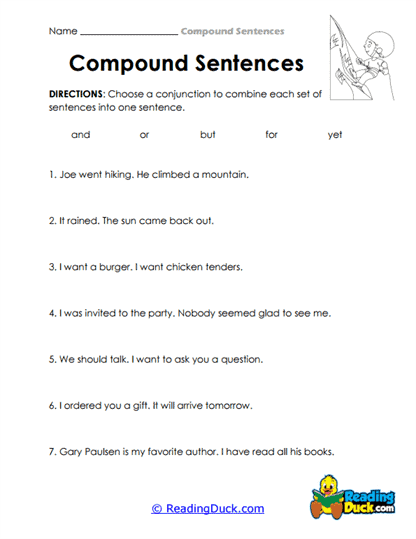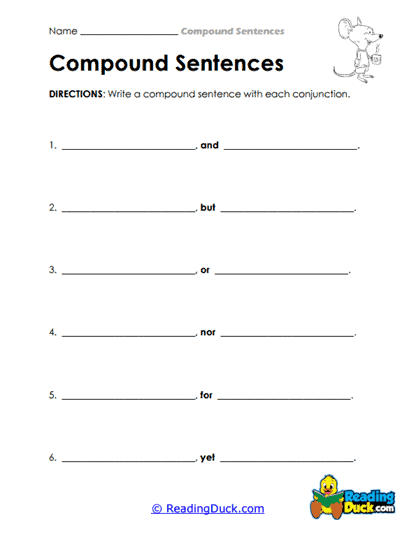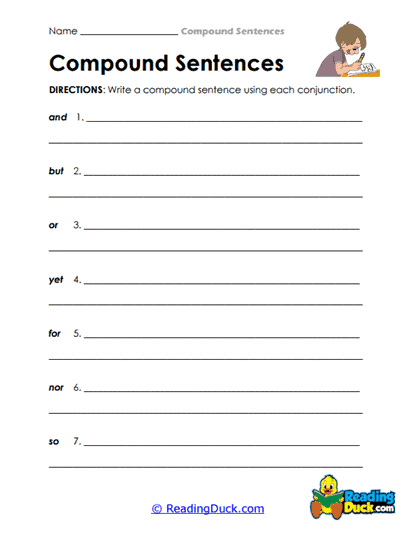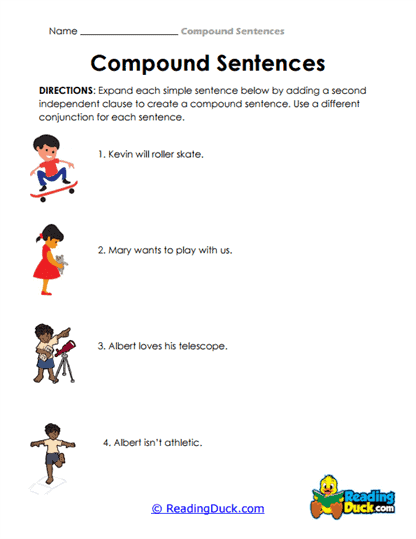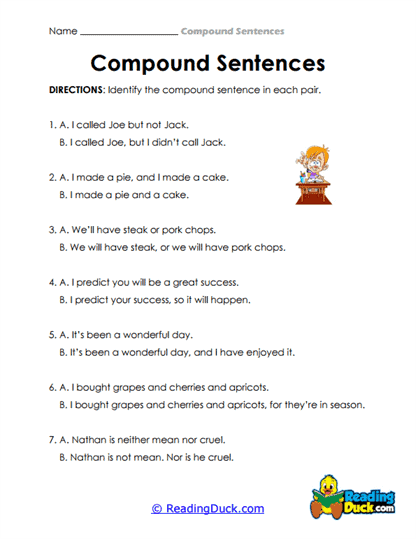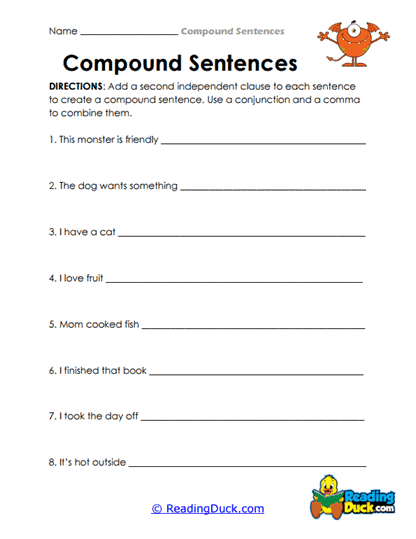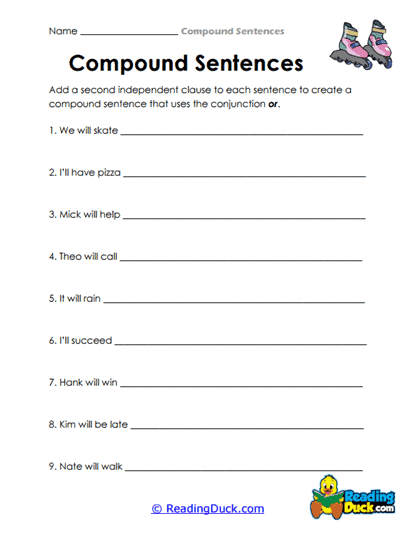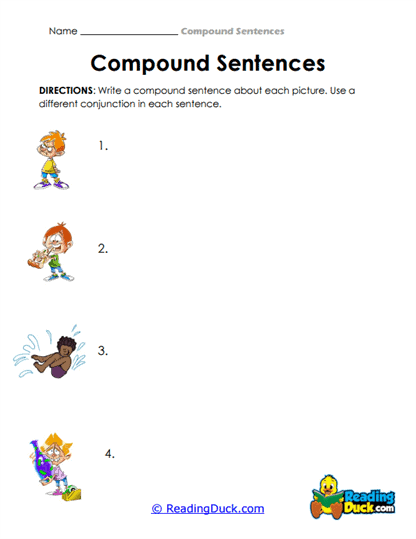Compound Sentences Worksheets
About Our Compound Sentences Worksheets
Our collection of Compound Sentences Worksheets is specifically designed to help students strengthen their understanding of sentence structure by mastering compound sentences. These worksheets provide comprehensive practice with connecting independent clauses using coordinating conjunctions, fostering a deeper understanding of how to create varied, clear, and engaging sentences. By working through these exercises, students will enhance their writing skills, allowing them to communicate ideas more effectively and write with greater fluidity.
Targeted toward elementary and middle school students, these worksheets are suitable for use in classrooms, homeschool settings, or independent study. Each worksheet offers a step-by-step approach to building compound sentences, from understanding basic definitions to applying those concepts in creative writing. This resource will equip students with the skills they need to create well-constructed sentences that improve the overall quality of their writing.
What Are Compound Sentences?
A compound sentence is a sentence that contains two or more independent clauses joined by a coordinating conjunction, such as "and," "but," or "so." Compound sentences are a great way to link related ideas, giving the writer the ability to expand on a topic while maintaining clarity. Unlike simple sentences, which express one idea, compound sentences combine two or more ideas into one cohesive thought, helping students create more detailed and varied writing.
For example:
- Simple sentences: I went to the store. I bought some apples.
- Compound sentence: I went to the store, and I bought some apples.
In this example, two independent clauses—each of which could stand alone as a sentence—are connected by the coordinating conjunction "and."
Key components of compound sentences:
- Independent clauses: Each independent clause can function as a complete sentence on its own.
- Coordinating conjunctions: These include words like "for," "and," "nor," "but," "or," "yet," and "so" (often remembered by the acronym FANBOYS).
- Punctuation: A comma is typically placed before the coordinating conjunction to separate the two independent clauses.
Why are compound sentences important in writing? They allow students to:
- Add variety to their writing by combining related thoughts.
- Link ideas logically, helping readers understand the relationship between them.
- Improve the flow and rhythm of their sentences.
By using compound sentences, students can create more engaging writing that connects their ideas more clearly and naturally. These worksheets break down the structure of compound sentences and guide students in creating their own, ensuring they grasp both the form and function of this essential writing tool.
Aligning with Key Learning Objectives
Our Compound Sentences Worksheets are specifically aligned with core objectives in writing curricula, ensuring that students develop the foundational skills needed to become effective writers. Teachers can use these worksheets to support key writing goals, such as understanding sentence structure, improving coherence, and enhancing descriptive clarity.
Here’s how these worksheets meet important writing objectives:
- Sentence structure: Students learn the mechanics of forming compound sentences, improving their overall sentence variety and syntactic knowledge. They practice identifying independent clauses and linking them with the appropriate conjunctions.
- Coherence and flow: Compound sentences help connect ideas more smoothly, making writing easier to read and more cohesive. This is essential for both narrative writing and expository essays.
- Descriptive clarity: By combining ideas with compound sentences, students can add depth to their descriptions and create more nuanced writing. For example, instead of writing disconnected sentences, they can build more complete thoughts that convey their meaning with precision.
Teachers can integrate these worksheets into larger writing units or project-based learning activities to reinforce sentence construction. For example, in a creative writing unit, students could use compound sentences to improve dialogue between characters or add detail to scene descriptions. In research papers, compound sentences can help students explain complex ideas more clearly by linking related information.
Encouraging Creativity and Self-Expression
While the primary focus of the worksheets is on the mechanics of writing compound sentences, they also foster creativity and self-expression. Writing with compound sentences allows students to communicate their thoughts more richly and fully, giving them the tools to experiment with language and style. Whether writing personal narratives, descriptive essays, or creative stories, compound sentences offer a way to enhance the overall quality of their writing.
For instance, when students work on descriptive writing or describing objects, compound sentences enable them to weave together multiple descriptive elements into one cohesive sentence. Instead of writing a series of simple sentences, students can connect related descriptions, creating a more engaging and fluid narrative.
Consider the difference:
- Simple sentences: The sky was dark. The stars were bright.
- Compound sentence: The sky was dark, but the stars were bright.
The compound sentence not only conveys more information but also illustrates a contrast between the two ideas. This helps students explore the relationships between their thoughts and encourages them to think more critically about how they structure their writing.
The creative possibilities are endless. With these worksheets, students can build sentences that not only follow grammatical rules but also add depth, emotion, and clarity to their writing.
Clear Instructions and Minimal Preparation
Our Compound Sentences Worksheets are designed with ease of use in mind, making them accessible to both students and educators. Each worksheet provides clear, step-by-step instructions that guide students through the process of identifying and creating compound sentences. This structure makes the worksheets ideal for:
- Classroom instruction: Teachers can easily incorporate these worksheets into their lesson plans with minimal preparation, freeing up more time for discussion and interactive learning.
- Homework assignments: The worksheets are perfect for reinforcing classroom learning through independent practice, helping students apply what they’ve learned in a structured format.
- Homeschooling: Parents can use the worksheets as part of a comprehensive writing curriculum, ensuring their children understand essential sentence structures and improve their overall writing skills.
- Independent study: Students looking to enhance their writing on their own can use these worksheets to gain valuable practice and improve their understanding of sentence construction.
With straightforward instructions and a variety of exercises, these worksheets can be tailored to meet the needs of different learners. Whether students are just beginning to explore compound sentences or need extra practice to solidify their understanding, the worksheets are flexible enough to accommodate varying levels of proficiency.
Adaptability in Various Learning Environments
One of the key benefits of our Compound Sentences Worksheets is their adaptability across multiple learning environments. Whether you’re teaching in a traditional classroom, managing a virtual learning environment, or guiding students through homeschooling, these worksheets offer the flexibility to enhance your writing instruction.
- Classroom use: Teachers can incorporate these worksheets into grammar lessons, creative writing units, or as part of regular writing practice. The worksheets provide a structured approach that fits seamlessly into any curriculum.
- Remote learning: These worksheets are easily downloadable and can be shared on digital platforms, making them ideal for online learning environments where students can complete them independently or as part of a virtual class.
- Homeschooling: Parents can use these worksheets as part of their writing instruction, ensuring their children develop a strong understanding of sentence structure while offering opportunities for creative expression.
- Independent study: Self-motivated learners can benefit from these worksheets as a tool for mastering sentence structure at their own pace, with exercises that build confidence and proficiency in writing.
Because each worksheet is designed to be self-contained, they offer maximum flexibility for teachers, parents, and students. Educators can select specific worksheets that target areas where students need improvement or assign multiple worksheets to build a more comprehensive understanding of compound sentences.
Our Compound Sentences Worksheets offer an effective and engaging way to help students improve their writing by mastering the art of creating compound sentences. These worksheets provide clear instructions and varied exercises, making them suitable for classroom use, homeschooling, or independent study. By completing these worksheets, students will develop the skills necessary to construct well-formed compound sentences, contributing to better sentence variety, improved coherence, and more engaging writing overall.
Whether your goal is to strengthen sentence structure, foster creativity, or build writing confidence, this collection of worksheets provides the tools students need to succeed. With minimal preparation, adaptability across different learning environments, and alignment with key writing objectives, these worksheets are an invaluable resource for teachers, parents, and students alike.


